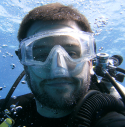Self-Reliant Diver Course - Dive 2 |
May 19, 2019 |
The second training dive of the Self-Reliant Diver Course involved some planning. The main item to plan was how much air would be necessary for the dive using the surface air consumption (SAC) rate determined on the first dive of the course, which was 20 litres/minute.
Here are the formulas:
Air required = SAC * ((depth + 10 metres) / 10) * time * 1.5 reserve
Cylinder size in litres = air required / maximum pressure
For the second dive we planned for a max depth of 12 metres for 50 minutes and here's how the formulas worked out.
Air required = 20 * ((12 + 10) / 10) * 50 * 1.5 = 3300 litres
Cylinder size = 3300 / 200 = 16.5 litre cylinder
I was using an 11 litre cylinder main tank, which meant I need an extra 5.5 litre cylinder. However, the pony bottle I used on the first dive was only a 2.7 litre cylinder. That meant I need a larger cylinder as my redundant air supply and the only larger cylinders available were the 11 litre cylinders.
So I went on the dive with one 11 litre cylinder on my back and one 11 litre cylinder in front of me clipped to the left-hand side of my BCD. It was actually a lot less awkward managing a cylinder of that size in front of me than I expected it to be.
The second training dive had a number of objectives:
- Navigate with a compass
- Navigate without a compass using natural references
- Swim for at least 2 minutes without a mask
- Swim to calculate my surface air consumption (SAC)
- Deploy a surface marker buoy (SMB) on reel with a line
- Switch to the redundant air supply
- Write the depth and air pressure on a slate at 10 minute intervals
Writing the depth and air pressure on a slate at 10 minute intervals was a snap with my nifty new slate.

Navigation with a compass turned out to be a bit tricky. I went north for 15 kick cycles, turned around, went south for 15 kick cycles and didn't quite wind up where I started. I was still within 6 metres of my starting point so I still met the objective but I think the weight and balance of the tank clipped to my front threw off my navigation a bit.
Natural navigation without a compass turned out to be much easier. At this site there is a weed line on which the dive flag was anchored. It was simply a matter of following the weed line for 15 kick cycles, turning around, and following the weed line back for 15 kick cycles.
I brought my GoPro on the dive without the intention of using it. I simply wanted to have it as part of my gear because I would normally have it as part of my gear so I might as well train with it. As we were navigating along the weed line, we happened across a seahorse! I've never seen a seahorse in the wild before so an exception had to be made and I pulled my GoPro and got a quick shot.

Seahorse
This perfectly highlights my desire to do solo diving. It would have been great to spend 5 minutes on this one encounter. But I still had objectives to complete so we had to keep moving.
Swimming for 2 minutes without a mask wasn't easy but it also wasn't too bad either. The biggest shock was just how cold my eyeballs were without the mask. I took my mask off and kept my eyelids closed but I the cold on my eyeballs was pretty intense. Once the mask was off, I rested my hand on my instructors tank and she went for a 2 minutes swim with me in tow. Getting my mask back on was a relief.
The swim to calculate my SAC rate was similar to the first dive of the course. Switching to the redundant air supply also went smoothly and I stayed in control of my buoyancy the whole time.
Deploying my SMB went much better than the first dive of the course. I had moved my own SMB to a much more accessible spot on my BCD and I had been practicing with it on dry land. It took a couple of breaths but I inflated it without any trouble and let it shoot to the surface on the line while I held the reel. I then slowly wound the line up on the reel as we made our ascent and did our 3 minute safety stop for the end of the dive. Since my GoPro was already out, I took another quick shot.

Kau Bay
| Location: Wellington, Kau Bay, New Zealand |
Statistics
|
|
|
Comments
blog comments powered by Disqus

